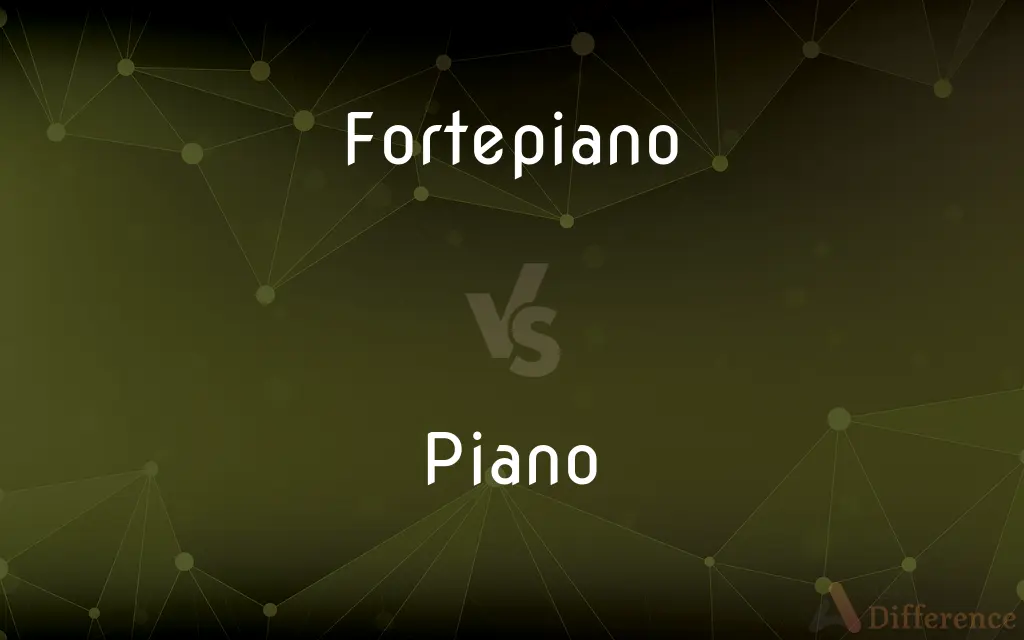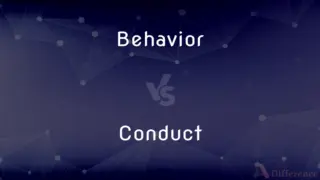Fortepiano vs. Piano — What's the Difference?
By Tayyaba Rehman — Updated on November 4, 2023
Fortepiano refers to an early piano design from the 18th century with a lighter, more delicate sound; a modern piano has a more robust structure and sound.

Difference Between Fortepiano and Piano
Table of Contents
ADVERTISEMENT
Key Differences
The fortepiano and piano differ in their historical context and construction. The fortepiano, developed in the 18th century, was the early version of the piano and was used by composers such as Mozart and Beethoven. It has a lighter frame, thinner strings, and softer hammers, producing a lighter and more transparent sound compared to the modern piano. The modern piano, on the other hand, developed during the 19th century, has a heavier construction, thicker strings, and is equipped with a more powerful frame capable of withstanding increased string tension, leading to a louder and more resonant sound.
When discussing dynamics and sound, the fortepiano offers a wider range of expression in soft dynamics, allowing for a nuanced performance of classical pieces. It is characterized by a rapid decay of sound, which influences the way musicians articulate notes. The piano, with its improved action and string durability, offers a broad dynamic range and sustained tones, making it well-suited for a wide repertoire, from classical to modern genres.
The action mechanism of the fortepiano is simpler than that of the modern piano. The fortepiano's action has fewer parts and is more directly connected to the keys, which allows for subtle control but less power. The modern piano's action is a complex mechanism called the double escapement, invented by Érard, which allows for repeated notes to be played faster and with greater control over dynamics.
Maintenance and tuning of a fortepiano versus a modern piano can also differ significantly. Fortepianos typically require more frequent tuning due to their less robust construction and are more sensitive to changes in humidity and temperature. Modern pianos are designed to hold their tuning for longer periods and are generally more durable and stable, reflecting advancements in materials and construction techniques.
In terms of repertoire, the fortepiano is often associated with the performance of music from the Baroque to the early Romantic periods, aligning with the instrument's historical period. The piano, having benefited from continued development, is versatile enough to encompass the fortepiano's repertoire while also being the instrument of choice for later Romantic, contemporary, and popular music.
ADVERTISEMENT
Comparison Chart
Time Period
18th century
19th century to present
Sound Characteristic
Lighter, more delicate sound
Louder, more resonant sound
Action Mechanism
Simpler, allowing nuanced control
Double escapement, allowing powerful dynamics
String and Frame Construction
Lighter frame, thinner strings
Heavier frame, thicker strings
Repertoire
Baroque to early Romantic
Broad, including all periods
Dynamic Range
Wider at softer dynamics
Wider across all dynamics
Maintenance and Tuning Frequency
Requires more frequent tuning
More stable, holds tuning longer
Compare with Definitions
Fortepiano
Has a lighter construction than the modern piano.
The fortepiano’s light construction made it easier to transport for performances.
Piano
Has a heavier frame and thicker strings for a richer sound.
The piano's robust sound resonated through the concert hall.
Fortepiano
Characterized by a transparent tone quality.
The fortepiano’s transparent tone is well-suited for classical repertoire.
Piano
The piano is an acoustic, stringed musical instrument invented in Italy by Bartolomeo Cristofori around the year 1700 (the exact year is uncertain), in which the strings are struck by wooden hammers that are coated with a softer material (modern hammers are covered with dense wool felt; some early pianos used leather). It is played using a keyboard, which is a row of keys (small levers) that the performer presses down or strikes with the fingers and thumbs of both hands to cause the hammers to strike the strings.
Fortepiano
An early version of the piano with a quieter sound.
The fortepiano's gentle tones filled the room with an 18th-century melody.
Piano
A large keyboard musical instrument with a wooden case enclosing a soundboard and metal strings, which are struck by hammers when the keys are depressed. The strings' vibration is stopped by dampers when the keys are released and can be regulated for length and volume by two or three pedals.
Fortepiano
Often requires more frequent tuning.
The museum’s fortepiano is tuned regularly to preserve its historic sound.
Piano
A passage performed or marked to be performed softly.
Fortepiano
Used by classical composers like Mozart.
Mozart composed his concertos with the sound of the fortepiano in mind.
Piano
(especially as a direction) soft or softly.
Fortepiano
A fortepiano [ˌfɔrteˈpjaːno] is an early piano. In principle, the word "fortepiano" can designate any piano dating from the invention of the instrument by Bartolomeo Cristofori around 1700 up to the early 19th century.
Piano
(especially as a direction) soft or softly.
Fortepiano
Any of various precursors to the modern piano.
Piano
A musical instrument with a manual keyboard actuating hammers that strike wire strings, producing sounds that may be softened or sustained by means of pedals.
Fortepiano
A keyboard instrument; the smaller, quieter precursor to the pianoforte.
Piano
A passage to be played softly or quietly.
Piano
In a soft or quiet tone. Used chiefly as a direction.
Piano
(musical instruments) a percussive keyboard musical instrument, usually ranging over seven octaves, with white and black colored keys, played by pressing these keys, causing hammers to strike strings
The piano in his house takes up a lot of space.
She has been taking lessons for many years and now plays piano very well.
Piano
To play the piano.
Piano
(of or with fingers) To move (the fingers) up and down on, similar to the motions of a pianist playing the piano.
Piano
To equip with a piano.
Piano
To become softer and less intense.
Piano
(music) softly, as a musical direction (abbreviated to p. in sheet music)
Piano
(music) Soft, quiet.
Piano
(in extended use) Gentle, soft, subdued.
Piano
Soft; - a direction to the performer to execute a certain passage softly, and with diminished volume of tone. (Abbrev. p.
Piano
A well-known musical instrument somewhat resembling the harpsichord, and consisting of a series of wires of graduated length, thickness, and tension, struck by hammers moved by keys.
Piano
A stringed instrument that is played by depressing keys that cause hammers to strike tuned strings and produce sounds
Piano
(music) low loudness
Piano
Used chiefly as a direction or description in music;
The piano passages in the composition
Piano
Used as a direction in music; to be played relatively softly
Piano
A modern keyboard instrument with a broad dynamic range.
She practiced Chopin's nocturnes on the grand piano for hours.
Piano
Evolved from earlier instruments like the fortepiano.
The modern piano offers a fuller sound than the fortepiano it descended from.
Piano
Used in a wide variety of musical genres.
He could play jazz, classical, and pop music on the piano.
Piano
Typically requires less frequent tuning than a fortepiano.
Her piano stays in tune, even after months of playing.
Common Curiosities
How does a fortepiano differ from a modern piano?
A fortepiano has a lighter construction and simpler action, producing a more delicate sound.
Why does the fortepiano require more frequent tuning?
The fortepiano's lighter construction and materials make it more sensitive to environmental changes.
What is a fortepiano?
A fortepiano is an early piano used in the 18th and early 19th centuries with a lighter sound.
Can the same music be played on both fortepiano and piano?
Yes, but each instrument brings out different nuances of the music.
Is the fortepiano still used today?
Yes, the fortepiano is still used, especially for historically informed performances of classical music.
What improvements were made to develop the piano from the fortepiano?
The piano has a stronger frame, thicker strings, and an advanced action mechanism for greater sound and control.
How often should a piano be tuned?
A piano typically should be tuned at least once or twice a year, depending on use and environmental conditions.
How has the sound of the piano changed from the fortepiano?
The piano has a fuller, more resonant sound with the ability to sustain notes longer.
What genres are best suited for the fortepiano?
The fortepiano is best suited for baroque, classical, and early romantic music.
Who commonly used the fortepiano?
Composers like Mozart and Beethoven used the fortepiano in their compositions.
Are pianos still evolving?
Yes, pianos continue to evolve with new materials and technology to improve sound and playability.
What is a piano?
A piano is a modern keyboard instrument with a wide dynamic range used across many genres.
Do pianists specialize in playing the fortepiano?
Some pianists do specialize in the fortepiano, particularly those interested in historical performance practice.
Can a piano emulate a fortepiano?
Some modern pianos have features that can mimic the sound of a fortepiano.
What genres are best suited for the piano?
The piano is suited for all genres, from classical to contemporary and jazz to pop.
Share Your Discovery

Previous Comparison
Polyester vs. Satin
Next Comparison
Behavior vs. ConductAuthor Spotlight
Written by
Tayyaba RehmanTayyaba Rehman is a distinguished writer, currently serving as a primary contributor to askdifference.com. As a researcher in semantics and etymology, Tayyaba's passion for the complexity of languages and their distinctions has found a perfect home on the platform. Tayyaba delves into the intricacies of language, distinguishing between commonly confused words and phrases, thereby providing clarity for readers worldwide.














































